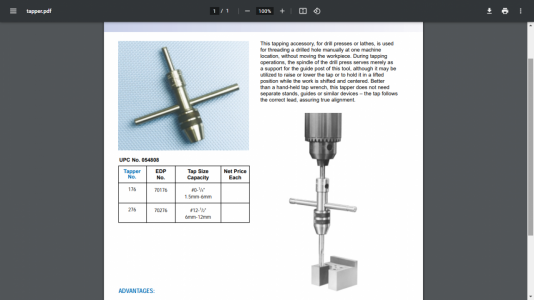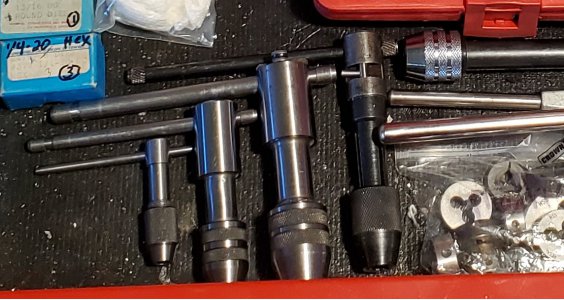I have a number of tap wrenches, some good, some OK, some not so good. None are what is referred to as "name brand". Where I wanted to join the conversation is with small taps. Some Most folks consider a 4-40 tap to be tiny. It isn't, by a long shot. In my work, a 4-40 is large.
I have "normal" sized taps and dies. 3/16 up to 3/4 inch, 18mm(?). That get used once or twice over a several year span. To me, a 2-56 is "normal", my sizes go down from there. I go down to 000-120.(3/0) There are smaller sizes, 4/0-160 and other "optical" sizes, but I don't use them. A 3/0 is 0.034 outer diameter. 0.035 clearance drill. . . And work sometimes in the metric versions. It all depends on when and where the original was made. If it's metric to start with, I try to stay metric.
It is well known that a 6-32 tap is very easy to break. Depth of thread vs solid body. Almost a spiral, 6-40 is a much better choice when it will fit. The whole point here is that for small taps, 4/40 and down, I use pin vises as tap wrenches. 5-40, 6-32, and 8-32 have a screwdriver handle. Klien makes an electrician's tool where the smallest, 6-32, is replacable. 5-40 is a drop in when needed. The larger sizes, 8-32 and 10-32 are ground on the shaft. The 6-32 is replacable because it so often breaks. Smaller than that, working a pin vise with my fingertips gives me a better "feel" for the tap. I can feel the teeth digging in and if it hits a hard spot, I know it right away. Or if things are really bad, the chuck will slip. A small tap wrench gives too much leverage, even a "T" handle, I can't feel what is going on.
I realize I am speaking about taps smaller than "run of the mill". But it is very often that people will try to work a 4-40 or 6-32 tap like it was a 1/4-20 or larger. And, of course, break it off. That is my point to expounding so much on the subject.
.



